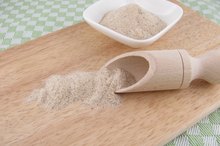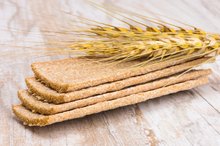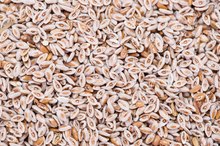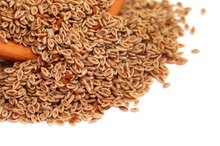Oat Bran Vs. Oatmeal for Cholesterol
Scientific evidence suggests a high-fiber diet lowers cholesterol levels. There are a variety of classifications for fiber, such as soluble and insoluble, viscous and nonviscous, and while all fiber seems to possess some cholesterol-lowering properties, certain types might be more effective than others. Oats and wheat are rich sources of fiber, though two completely different kinds. According to studies, oat bran appears more effective at lowering cholesterol than wheat bran and oatmeal.
Oatmeal vs. Oat Bran
Clinical trials have shown that increasing consumption of oat products lowers LDL, or "bad," cholesterol and total serum cholesterol levels, in part because of the high concentrations of soluble fiber and beta glucan fiber in particular. One cup of cooked oat bran contains 5.7 g of fiber, while 1 cup of cooked oatmeal contains 4 g. For this reason, you could eat less oat bran to get the same amount of cholesterol-lowering beta glucans in your diet as you would eating oatmeal.
Oat Bran vs. Wheat Bran
Shredded Wheat & Cholesterol
Learn More
Oatmeal and oat bran contain soluble, viscous fiber, while wheat bran has insoluble, nonviscous fiber. Research has found that viscous, soluble fibers are more effective in lowering levels of LDL cholesterol than nonviscous fibers. This is because soluble fibers dissolve in the intestines into a viscous gel that helps eliminate cholesterol by binding to it before it can be absorbed into the bloodstream, whereas insoluble fiber passes through the gastrointestinal tract relatively undigested.
Fiber and Cardiovascular Health
The American Heart Association says including fiber, and soluble fiber in particular, in a generally low-fat diet may help reduce risk of heart disease. Soluble fiber also appears to lower LDL cholesterol without lowering HDL, or "good," cholesterol. Insoluble fiber may not lower cholesterol levels as much, but it has other cardiovascular benefits that include lowering blood pressure and blood-sugar and insulin levels. The 2005 Dietary Guidelines for Americans recommends consuming 14 g of fiber for every 1,000 calories, though most Americans eat a total of 14 g of fiber per day.
Precautions
How Much Oatmeal Is Needed to Reduce Cholesterol?
Learn More
There is not much bran in commercial products marketed for their oat and wheat bran content, such as so-called bran muffins. These products are proportionately higher in sodium and saturated, trans and total fat, which effectively cancels out any cholesterol-reducing benefits of whatever bran those products do contain. In rare cases, reports have surfaced of intestinal obstructions associated with consumption of large quantities of oat and wheat bran, typically in those who already have trouble moving their bowels or difficulty chewing.
Related Articles
Writer Bio
Based in Maine, Sage Kalmus has written extensively on fitness, nutrition, alternative health, self-improvement and green living for various websites. He also authored the metaphysical fiction book, "Free Will Flux." Kalmus holds a Bachelor of Science from Boston University's College of Communication and is a Certified Holistic Health Counselor with special training in Touch-For-Health Kinesiology.









